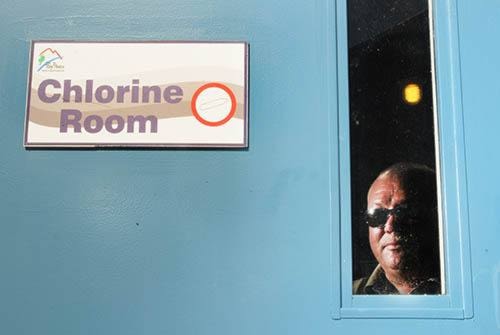The Leisure Centre in Maple Ridge was evacuated again on Tuesday after the fourth chlorine leak at the indoor pool in three years.
The evacuation follows a leak in the chlorine room on Jan. 31, after which a WorkSafe B.C. report found a faulty chlorine monitor and that recreation staff weren’t checking them as often as required.
“Three leaks in the last two years, that’s just nuts,” said Brian Northam, a health and safety officer with the Greater Vancouver Regional District Employees Union and who was at the Leisure Centre on Tuesday.
“The leak should never have been able to propagate to the required emergency response,” involving the Maple Ridge fire department.
Lifeguards and staff emptied the pool at about 5:30 p.m. after an alarm sounded indicating a chlorine leak, triggering the evacuation.
Chlorine gas is injected into the pool’s water supply from compressed chlorine gas tanks in a separate room in the southwest corner of the Leisure Centre.
No one was injured in the incident.
But it could have been more serious, said Northam.
According to the website Toxipedia, chlorine gas can be smelled at 3.5 parts per million and can be fatal after a few breaths at 1,000 parts per million. Chlorine also was used as a chemical weapon by the Germans against the Allies in the First World War.
“If this gets on your skin, you’re going to blister.”
If you breath it in, Northam added, death could result.
He said each workplace has to be able to do its own evacuation procedures.
“What happens if the fire department had a three-alarm fire?”
Staff did evacuate the pool, said recreation director Wendy McCormick.
A sensor detected the chlorine leak and sounded the alarm. Staff immediately evacuated the pool and the building and 911 was called.
“Everything shuts down as soon as there’s a breech,” regardless of whether there’s power, McCormick said.
“We have automatic shut-off valves and they all worked just like they were supposed to. We test them regularly.”
Northam also said pool staff are also using outdated breathing apparatus, which means they’re not getting regular training.
McCormick, though, said only senior maintenance staff or senior lifeguards, about 20 in all, enter the chlorine room and do so with masks that are tested and fitted yearly.
“These are all new masks that they wear if they’re going into that room.”
Staff, though, don’t enter the room if there’s an emergency. If the alarm sounds and there’s a chlorine leak, 911 is called.
“They’re not going in the room if there’s a spill,” she said.
The room can only be accessed from the exterior and not from the pool deck.
“There’s no way for that chlorine to get to the pool deck.”
Also, with automatic shut-off valves on each tank, chlorine can’t build up to high enough concentrations to be dangerous to passersby outside the Leisure Centre or in the adjacent Haney Place Mall. Only a catastrophic circumstance could result in such a scenario, but in that case, firefighters would be on hand and the area would be evacuated, McCormick said.
“We’d have to have all kinds of things fail for that to happen.”
McCormick said that the leaks in 2011 and 2012 and again on Tuesday has the recreation department reconsidering another way to disinfect the pool water.
WorkSafe B.C. followed the two previous incidents with inspections and orders, which the district quickly followed, she added.
“And we do fall into compliance in a short period of time.”
The pool meets all safety regulations and would be shut down if it wasn’t, she said.
The pool also was evacuated last Feb. 13 following another leak in the chlorine room, where a faulty stationary monitor showed readings of 2.4 parts per million, while a portable monitor showed levels of 20 parts per million.
According to a WorkSafe report from that incident, chlorine is dangerous to health at 10 ppm.
WorkSafe also found that the district wasn’t checking the monitors every month, contrary to Operational Health and Safety Regulations, and that staff entered the chlorine room when there was a leak, contrary to regulations, and without calling 911.
Maple Ridge’s recreation department is looking at converting to a new water treatment system – a combination of ultra-violet light and liquid chlorine, similar to bleach – in order to purify the water. But that’s costly.
“We don’t want to see this happening regularly. We’re certainly looking at it,” McCormick said.
Gas chlorine though probably works best at keeping the water crystal clean and clear, she added.
Tuesday’s leak and the one in 2012 were both caused by faulty regulators, a device located near the tanks, which governs the flow of gas. The district is contacting the supplier of those regulators.
“They shouldn’t be failing,” McCormick said.
People returned to the pool about two hours later.
